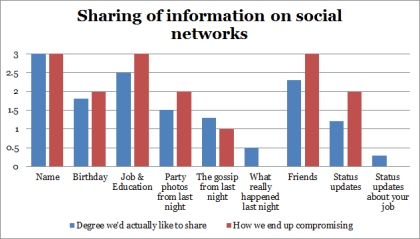Filed under: Uncategorized | Tags: advertising, Google, marketing, social media
Okay, so Google’s strategy is that customer value comes first and monetisation will follow. So here’s my take on how the customer value of Circles in Google+ translates to 2 pieces of genius from a marketer’s perspective.
In case you’re not familiar with Google+ and the concept of Circles: Google+ is the latest social networking site (started by Google, in case you weren’t sure) to hit the scene. Unofficial figures say that it’s reached 20 million users in less than a month, which makes it one to watch. Though it’s touted by many commentators as a ‘Facebook-killer’ the functionality is more of a Facebook/Twitter cross.
One of the key differences to both of the aforementioned is ‘Circles’, where your contacts can be put into separate groups as opposed to just being your ‘Friend’ or ‘Follower’. This means that content can be shared with a limited group defined by the user – on the one platform you can discuss work with your colleagues or share last night’s party photos with your party people, and ne’er the twain shall meet.
On to those two bits of genius…
I’ve been speaking to a lot of people who are trying to figure out what value their business can derive from social networks. A lot of people like to focus on the ‘glamourous’ side – giveaways, viral videos, gaining followers etc. Well, they’re important, but I really believe there’s more value in being able to target the right people at the right time and find out what they’re really thinking. So here’s what I’m hoping to get from Google+…
1. More sharing
Privacy is an interesting thing. It used to be that you could very easily keep separate parts of your life, well, separate. It was purely 1 to 1; f you wanted to write illicit love letters to 5 different people, they would only find out if they compared notes.
Then came technology, with email, blogging, social networking, microblogging, and more. We had 4 ways to share; 1 to 1, 1 to friends, 1 to every1, or ‘dammit I’m not telling anyone’. Most of us learnt this the hard way on Facebook. We wanted to share content with a limited group of friends, but suddenly all of our ‘friends’ or even the whole world could see. As a consequence, there were some types of information that we just stopped sharing altogether.
Here’s an example:

As you can see, you might want to share at several different degrees, but you often end up sharing with more or less people that you would like to.
Circles, as I’ve explained, allows you to share in degrees the way we want to. It means that you have more privacy – if you added up all of the bars above, you’d find that you are sharing to a lesser degree as a whole. However, you’re actually putting MORE information out there because you can limit the degree it’s shared.
More data being shared is marketer’s gold. Share more information and I can get a bigger picture of who you are, how you live, what you like and what you dislike. It tells me what I should share with you and when I should do it.
If Google can tap into more data, they have a very powerful tool for their ad network.
2. Ads in a social context
The jump to social media came from one premise; I am more interested in people I know than people I don’t. I care about what my friends are doing but I don’t really care what a stranger had for breakfast. I know that my friends have good taste in music and I’ll trust that more than a record company telling me their latest artist is fantastic.
As a marketer, I’m interested in two things from this; insight and influence.
Circles allows us to map social structure like never before.
Since each circle created represents a specific social group or interest, we know that if A, B, C and D are listed as being in the same circle by many people, chances are that if A, B and C all click on ads related to cars then D may be more likely to also click on a car ad. This ‘social logic’ allows us to imply insights from people that share their data to people that share less.
Since adding someone to a circle is a one-sided act, it is easier for us to see who influences who. If A is following B but B is not following A, B is the more influential. I can get more value out of targeted advertising to B as an influencer than A as the follower. (This one-sided mechanism is why Twitter is used as a better quick yardstick of influence than Facebook, except that Twitter does not have the mechanisms in place to take advantage of this.)
So what does this mean?
I’m not here to make predictions about whether Google+ will take over from Facebook or completely change the social networking game. However, I will say that if they manage to make the network a success, Google will have no problems in monetising it and getting businesses on board.
The two factors I’ve discussed may be subtle…but they’re also genius.
Leave a Comment so far
Leave a comment


